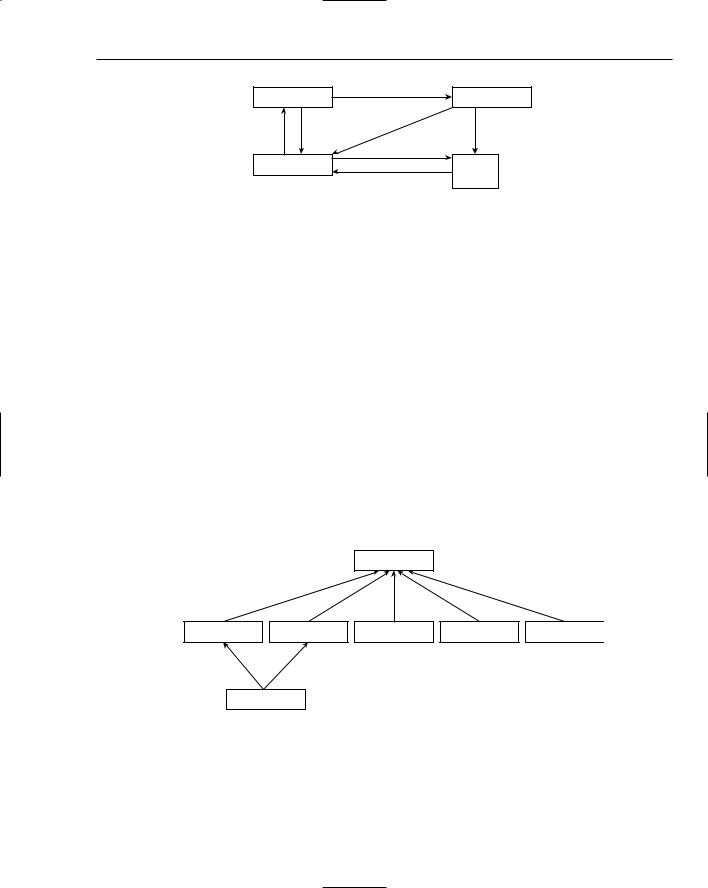
- •Contents
- •Introduction
- •Who This Book Is For
- •What This Book Covers
- •How This Book Is Structured
- •What You Need to Use This Book
- •Conventions
- •Source Code
- •Errata
- •p2p.wrox.com
- •The Basics of C++
- •The Obligatory Hello, World
- •Namespaces
- •Variables
- •Operators
- •Types
- •Conditionals
- •Loops
- •Arrays
- •Functions
- •Those Are the Basics
- •Diving Deeper into C++
- •Pointers and Dynamic Memory
- •Strings in C++
- •References
- •Exceptions
- •The Many Uses of const
- •C++ as an Object-Oriented Language
- •Declaring a Class
- •Your First Useful C++ Program
- •An Employee Records System
- •The Employee Class
- •The Database Class
- •The User Interface
- •Evaluating the Program
- •What Is Programming Design?
- •The Importance of Programming Design
- •Two Rules for C++ Design
- •Abstraction
- •Reuse
- •Designing a Chess Program
- •Requirements
- •Design Steps
- •An Object-Oriented View of the World
- •Am I Thinking Procedurally?
- •The Object-Oriented Philosophy
- •Living in a World of Objects
- •Object Relationships
- •Abstraction
- •Reusing Code
- •A Note on Terminology
- •Deciding Whether or Not to Reuse Code
- •Strategies for Reusing Code
- •Bundling Third-Party Applications
- •Open-Source Libraries
- •The C++ Standard Library
- •Designing with Patterns and Techniques
- •Design Techniques
- •Design Patterns
- •The Reuse Philosophy
- •How to Design Reusable Code
- •Use Abstraction
- •Structure Your Code for Optimal Reuse
- •Design Usable Interfaces
- •Reconciling Generality and Ease of Use
- •The Need for Process
- •Software Life-Cycle Models
- •The Stagewise and Waterfall Models
- •The Spiral Method
- •The Rational Unified Process
- •Software-Engineering Methodologies
- •Extreme Programming (XP)
- •Software Triage
- •Be Open to New Ideas
- •Bring New Ideas to the Table
- •Thinking Ahead
- •Keeping It Clear
- •Elements of Good Style
- •Documenting Your Code
- •Reasons to Write Comments
- •Commenting Styles
- •Comments in This Book
- •Decomposition
- •Decomposition through Refactoring
- •Decomposition by Design
- •Decomposition in This Book
- •Naming
- •Choosing a Good Name
- •Naming Conventions
- •Using Language Features with Style
- •Use Constants
- •Take Advantage of const Variables
- •Use References Instead of Pointers
- •Use Custom Exceptions
- •Formatting
- •The Curly Brace Alignment Debate
- •Coming to Blows over Spaces and Parentheses
- •Spaces and Tabs
- •Stylistic Challenges
- •Introducing the Spreadsheet Example
- •Writing Classes
- •Class Definitions
- •Defining Methods
- •Using Objects
- •Object Life Cycles
- •Object Creation
- •Object Destruction
- •Assigning to Objects
- •Distinguishing Copying from Assignment
- •The Spreadsheet Class
- •Freeing Memory with Destructors
- •Handling Copying and Assignment
- •Different Kinds of Data Members
- •Static Data Members
- •Const Data Members
- •Reference Data Members
- •Const Reference Data Members
- •More about Methods
- •Static Methods
- •Const Methods
- •Method Overloading
- •Default Parameters
- •Inline Methods
- •Nested Classes
- •Friends
- •Operator Overloading
- •Implementing Addition
- •Overloading Arithmetic Operators
- •Overloading Comparison Operators
- •Building Types with Operator Overloading
- •Pointers to Methods and Members
- •Building Abstract Classes
- •Using Interface and Implementation Classes
- •Building Classes with Inheritance
- •Extending Classes
- •Overriding Methods
- •Inheritance for Reuse
- •The WeatherPrediction Class
- •Adding Functionality in a Subclass
- •Replacing Functionality in a Subclass
- •Respect Your Parents
- •Parent Constructors
- •Parent Destructors
- •Referring to Parent Data
- •Casting Up and Down
- •Inheritance for Polymorphism
- •Return of the Spreadsheet
- •Designing the Polymorphic Spreadsheet Cell
- •The Spreadsheet Cell Base Class
- •The Individual Subclasses
- •Leveraging Polymorphism
- •Future Considerations
- •Multiple Inheritance
- •Inheriting from Multiple Classes
- •Naming Collisions and Ambiguous Base Classes
- •Interesting and Obscure Inheritance Issues
- •Special Cases in Overriding Methods
- •Copy Constructors and the Equals Operator
- •The Truth about Virtual
- •Runtime Type Facilities
- •Non-Public Inheritance
- •Virtual Base Classes
- •Class Templates
- •Writing a Class Template
- •How the Compiler Processes Templates
- •Distributing Template Code between Files
- •Template Parameters
- •Method Templates
- •Template Class Specialization
- •Subclassing Template Classes
- •Inheritance versus Specialization
- •Function Templates
- •Function Template Specialization
- •Function Template Overloading
- •Friend Function Templates of Class Templates
- •Advanced Templates
- •More about Template Parameters
- •Template Class Partial Specialization
- •Emulating Function Partial Specialization with Overloading
- •Template Recursion
- •References
- •Reference Variables
- •Reference Data Members
- •Reference Parameters
- •Reference Return Values
- •Deciding between References and Pointers
- •Keyword Confusion
- •The const Keyword
- •The static Keyword
- •Order of Initialization of Nonlocal Variables
- •Types and Casts
- •typedefs
- •Casts
- •Scope Resolution
- •Header Files
- •C Utilities
- •Variable-Length Argument Lists
- •Preprocessor Macros
- •How to Picture Memory
- •Allocation and Deallocation
- •Arrays
- •Working with Pointers
- •Array-Pointer Duality
- •Arrays Are Pointers!
- •Not All Pointers Are Arrays!
- •Dynamic Strings
- •C-Style Strings
- •String Literals
- •The C++ string Class
- •Pointer Arithmetic
- •Custom Memory Management
- •Garbage Collection
- •Object Pools
- •Function Pointers
- •Underallocating Strings
- •Memory Leaks
- •Double-Deleting and Invalid Pointers
- •Accessing Out-of-Bounds Memory
- •Using Streams
- •What Is a Stream, Anyway?
- •Stream Sources and Destinations
- •Output with Streams
- •Input with Streams
- •Input and Output with Objects
- •String Streams
- •File Streams
- •Jumping around with seek() and tell()
- •Linking Streams Together
- •Bidirectional I/O
- •Internationalization
- •Wide Characters
- •Non-Western Character Sets
- •Locales and Facets
- •Errors and Exceptions
- •What Are Exceptions, Anyway?
- •Why Exceptions in C++ Are a Good Thing
- •Why Exceptions in C++ Are a Bad Thing
- •Our Recommendation
- •Exception Mechanics
- •Throwing and Catching Exceptions
- •Exception Types
- •Throwing and Catching Multiple Exceptions
- •Uncaught Exceptions
- •Throw Lists
- •Exceptions and Polymorphism
- •The Standard Exception Hierarchy
- •Catching Exceptions in a Class Hierarchy
- •Writing Your Own Exception Classes
- •Stack Unwinding and Cleanup
- •Catch, Cleanup, and Rethrow
- •Use Smart Pointers
- •Common Error-Handling Issues
- •Memory Allocation Errors
- •Errors in Constructors
- •Errors in Destructors
- •Putting It All Together
- •Why Overload Operators?
- •Limitations to Operator Overloading
- •Choices in Operator Overloading
- •Summary of Overloadable Operators
- •Overloading the Arithmetic Operators
- •Overloading Unary Minus and Unary Plus
- •Overloading Increment and Decrement
- •Overloading the Subscripting Operator
- •Providing Read-Only Access with operator[]
- •Non-Integral Array Indices
- •Overloading the Function Call Operator
- •Overloading the Dereferencing Operators
- •Implementing operator*
- •Implementing operator->
- •What in the World Is operator->* ?
- •Writing Conversion Operators
- •Ambiguity Problems with Conversion Operators
- •Conversions for Boolean Expressions
- •How new and delete Really Work
- •Overloading operator new and operator delete
- •Overloading operator new and operator delete with Extra Parameters
- •Two Approaches to Efficiency
- •Two Kinds of Programs
- •Is C++ an Inefficient Language?
- •Language-Level Efficiency
- •Handle Objects Efficiently
- •Use Inline Methods and Functions
- •Design-Level Efficiency
- •Cache as Much as Possible
- •Use Object Pools
- •Use Thread Pools
- •Profiling
- •Profiling Example with gprof
- •Cross-Platform Development
- •Architecture Issues
- •Implementation Issues
- •Platform-Specific Features
- •Cross-Language Development
- •Mixing C and C++
- •Shifting Paradigms
- •Linking with C Code
- •Mixing Java and C++ with JNI
- •Mixing C++ with Perl and Shell Scripts
- •Mixing C++ with Assembly Code
- •Quality Control
- •Whose Responsibility Is Testing?
- •The Life Cycle of a Bug
- •Bug-Tracking Tools
- •Unit Testing
- •Approaches to Unit Testing
- •The Unit Testing Process
- •Unit Testing in Action
- •Higher-Level Testing
- •Integration Tests
- •System Tests
- •Regression Tests
- •Tips for Successful Testing
- •The Fundamental Law of Debugging
- •Bug Taxonomies
- •Avoiding Bugs
- •Planning for Bugs
- •Error Logging
- •Debug Traces
- •Asserts
- •Debugging Techniques
- •Reproducing Bugs
- •Debugging Reproducible Bugs
- •Debugging Nonreproducible Bugs
- •Debugging Memory Problems
- •Debugging Multithreaded Programs
- •Debugging Example: Article Citations
- •Lessons from the ArticleCitations Example
- •Requirements on Elements
- •Exceptions and Error Checking
- •Iterators
- •Sequential Containers
- •Vector
- •The vector<bool> Specialization
- •deque
- •list
- •Container Adapters
- •queue
- •priority_queue
- •stack
- •Associative Containers
- •The pair Utility Class
- •multimap
- •multiset
- •Other Containers
- •Arrays as STL Containers
- •Strings as STL Containers
- •Streams as STL Containers
- •bitset
- •The find() and find_if() Algorithms
- •The accumulate() Algorithms
- •Function Objects
- •Arithmetic Function Objects
- •Comparison Function Objects
- •Logical Function Objects
- •Function Object Adapters
- •Writing Your Own Function Objects
- •Algorithm Details
- •Utility Algorithms
- •Nonmodifying Algorithms
- •Modifying Algorithms
- •Sorting Algorithms
- •Set Algorithms
- •The Voter Registration Audit Problem Statement
- •The auditVoterRolls() Function
- •The getDuplicates() Function
- •The RemoveNames Functor
- •The NameInList Functor
- •Testing the auditVoterRolls() Function
- •Allocators
- •Iterator Adapters
- •Reverse Iterators
- •Stream Iterators
- •Insert Iterators
- •Extending the STL
- •Why Extend the STL?
- •Writing an STL Algorithm
- •Writing an STL Container
- •The Appeal of Distributed Computing
- •Distribution for Scalability
- •Distribution for Reliability
- •Distribution for Centrality
- •Distributed Content
- •Distributed versus Networked
- •Distributed Objects
- •Serialization and Marshalling
- •Remote Procedure Calls
- •CORBA
- •Interface Definition Language
- •Implementing the Class
- •Using the Objects
- •A Crash Course in XML
- •XML as a Distributed Object Technology
- •Generating and Parsing XML in C++
- •XML Validation
- •Building a Distributed Object with XML
- •SOAP (Simple Object Access Protocol)
- •. . . Write a Class
- •. . . Subclass an Existing Class
- •. . . Throw and Catch Exceptions
- •. . . Read from a File
- •. . . Write to a File
- •. . . Write a Template Class
- •There Must Be a Better Way
- •Smart Pointers with Reference Counting
- •Double Dispatch
- •Mix-In Classes
- •Object-Oriented Frameworks
- •Working with Frameworks
- •The Model-View-Controller Paradigm
- •The Singleton Pattern
- •Example: A Logging Mechanism
- •Implementation of a Singleton
- •Using a Singleton
- •Example: A Car Factory Simulation
- •Implementation of a Factory
- •Using a Factory
- •Other Uses of Factories
- •The Proxy Pattern
- •Example: Hiding Network Connectivity Issues
- •Implementation of a Proxy
- •Using a Proxy
- •The Adapter Pattern
- •Example: Adapting an XML Library
- •Implementation of an Adapter
- •Using an Adapter
- •The Decorator Pattern
- •Example: Defining Styles in Web Pages
- •Implementation of a Decorator
- •Using a Decorator
- •The Chain of Responsibility Pattern
- •Example: Event Handling
- •Implementation of a Chain of Responsibility
- •Using a Chain of Responsibility
- •Example: Event Handling
- •Implementation of an Observer
- •Using an Observer
- •Chapter 1: A Crash Course in C++
- •Chapter 3: Designing with Objects
- •Chapter 4: Designing with Libraries and Patterns
- •Chapter 5: Designing for Reuse
- •Chapter 7: Coding with Style
- •Chapters 8 and 9: Classes and Objects
- •Chapter 11: Writing Generic Code with Templates
- •Chapter 14: Demystifying C++ I/O
- •Chapter 15: Handling Errors
- •Chapter 16: Overloading C++ Operators
- •Chapter 17: Writing Efficient C++
- •Chapter 19: Becoming Adept at Testing
- •Chapter 20: Conquering Debugging
- •Chapter 24: Exploring Distributed Objects
- •Chapter 26: Applying Design Patterns
- •Beginning C++
- •General C++
- •I/O Streams
- •The C++ Standard Library
- •C++ Templates
- •Integrating C++ and Other Languages
- •Algorithms and Data Structures
- •Open-Source Software
- •Software-Engineering Methodology
- •Programming Style
- •Computer Architecture
- •Efficiency
- •Testing
- •Debugging
- •Distributed Objects
- •CORBA
- •XML and SOAP
- •Design Patterns
- •Index

Chapter 2
One language technique for writing general-purpose code in C++ is the template. The following example shows a templatized data structure. If you’ve never seen this syntax before, don’t worry! Chapter 11 explains the syntax in depth.
Instead of writing a specific ChessBoard class that stores ChessPieces, as shown earlier, consider writing a generic GameBoard template that can be used for any type of two-dimensional board game such as chess or checkers. You would need only to change the class declaration so that it takes the piece to store as a template parameter instead of hard-coding it in the interface. The template could look something like this:
template <typename PieceType> Class GameBoard {
public:
// This example omits constructors, destructors, and the assignment operator. void setPieceAt(PieceType* piece, int x, int y);
PieceType& getPieceAt(int x, int y); bool isEmpty(int x, int y);
protected:
// This example omits data members.
};
With this simple change in the interface, you now have a generic game board class that you can use for any two-dimensional board game. Although the code change is simple, it is important to make these decisions in the design phase, so that you are able to implement the code effectively and efficiently.
Reusing Ideas
As the baker example illustrates, it would be ludicrous to reinvent recipes for every dish that you make. However, programmers often make an equivalent mistake in their designs. Instead of utilizing existing “recipes,” or patterns, for designing programs, they reinvent these techniques every time they design a program. However, many design patterns appear in myriad different C++ applications. As a C++ programmer, you should familiarize yourself with these patterns so that you can incorporate them effectively into your program designs.
For example, you might want to design your chess program so that you have a single ErrorLogger object that serializes all errors from different components to a log file. When you try to design your ErrorLogger class, you realize that it would be disastrous to have more than one object instantiated from the ErrorLogger class in a single program. You also want to be able to access this ErrorLogger object from anywhere in your program. These requirements of a single, globally accessible, instance of a class arise frequently in C++ programs, and there is a standard strategy to implement them, called the singleton. Thus, a good design at this point would specify that you want to use the singleton pattern. Chapters 5, 25, and 26 cover design patterns and techniques in much more detail.
Designing a Chess Program
This section introduces a systematic approach to designing a C++ program in the context of a simple chess game application. In order to provide a complete example, some of the steps refer to concepts covered in later chapters. You should read this example now, in order to obtain an overview of the design process, but you might also consider rereading it after you have finished reading Part I.
50

Designing Professional C++ Programs
Requirements
Before embarking on the design, it is important to possess clear requirements for the program’s functionality and efficiency. Ideally, these requirements would be documented in the form of a requirements specification. The requirements for the chess program would contain the following types of specifications, although in more detail and number:
The program will support the standard rules of chess.
The program will support two human players. The program will not provide an artificially intelligent computer player.
The program will provide a text-based interface:
The program will render the game board and pieces in ASCII text.
Players will express their moves by entering numbers representing locations on the chessboard.
The requirements ensure that you design your program so that it performs as its users expect. You would not want to waste time designing and coding a graphical user interface for the chess game if the users desire only a text-based interface. Conversely, it would be important to be aware of a user preference for a graphical user interface, so that you don’t design the program in a way that precludes that possibility.
Design Steps
You should take a systematic approach to designing your program, working from the general to the specific. The following steps do not always apply to all programs, but they provide a general guideline. Your design should include diagrams and tables as appropriate. This example includes sample diagrams and tables. Feel free to follow the format used here or to invent your own.
There is no “right” way to draw software design diagrams as long as they are clear and meaningful to yourself and your colleagues.
Divide the Program into Subsystems
Your first step is to divide your program into its general functional subsystems and to specify the interfaces and interactions between the subsystems. At this point, you should not worry about specifics of data structures and algorithms, or even classes. You are trying only to obtain a general feel for the various parts of the program and their interactions. You can list the subsystems in a table that expresses the high-level behaviors or functionality of the subsystem, the interfaces exported from the subsystem to other subsystems, and the interfaces consumed, or used, by this subsystem on other subsystems. A table for the chess game subsystems could look like this:
51

Chapter 2
Subsystem Name |
Number |
Functionality |
Interfaces Exported |
Interfaces Consumed |
|
|
|
|
|
GamePlay |
1 |
Starts game |
Game Over |
Take Turn (on Player) |
|
|
Controls game |
|
Draw (on Chess |
|
|
flow |
|
Board) |
|
|
Controls drawing |
|
|
|
|
Declares winner |
|
|
|
|
Ends game |
|
|
Chess Board |
1 |
Stores chess pieces |
Get Piece At |
Game Over (on |
|
|
Checks for draws |
Set Piece At |
Game-Play) |
|
|
and checkmates |
Draw |
Draw (on Chess |
|
|
Draws itself |
|
Piece) |
Chess Piece |
32 |
Draws itself |
Draw |
Get Piece At (on |
|
|
Moves itself |
Move |
Game Board) |
|
|
Checks for legal |
Check Move |
Set Piece At (on |
|
|
moves |
|
Game Board) |
Player |
2 |
Interacts with |
Take Turn |
Get Piece At (on |
|
|
user: prompts |
|
Game Board) |
|
|
user for move, |
|
Move (on Chess |
|
|
obtains user’s |
|
Piece) |
|
|
move |
|
Check Move (on |
|
|
Moves pieces |
|
Chess Piece) |
ErrorLogger |
1 |
Writes error mes- |
Log Error |
None |
|
|
sages to log file |
|
|
|
|
|
|
|
As this table shows, the functional subsystems of this chess game include a GamePlay subsystem, a ChessBoard, 32 ChessPieces, two Players, and one ErrorLogger. However, that is not the only reasonable approach to a Chess Game. In software design, as in programming itself, there are often many different ways to accomplish the same goal. Not all ways are equal: some are certainly better than others. However, there are often several equally valid methods.
A good division into subsystems separates the program into its basic functional parts. For example, in the Chess Game, a Player is a subsystem distinct from the Board, Chess Pieces, or GamePlay. It wouldn’t make sense to lump the players into the GamePlay object because they are logically separate subsystems. Other choices are not as obvious. Would it be reasonable to add a separate User Interface subsystem?
If you intend to provide different kinds of user interfaces, or want to easily modify your interfaces later, you might want to separate out this aspect into a separate subsystem. To make these kinds of choices, you need to consider not only the current goals of the program, but future goals as well.
Because it is often difficult to visualize subsystem relationships from tables, it is usually helpful to show the subsystems of a program in a diagram, such as Figure 2-1. In this figure, arrows represent calls from one subsystem to another (for simplicity, the Error Logger subsystem is omitted).
52

Designing Professional C++ Programs
GamePlay
Game Draw
Over
ChessBoard
Figure 2-1
TakeTurn
GetPieceAt
Draw
GetPieceAt
SetPieceAt
Player
Move
CheckMove
Chess
Piece
Choose Threading Models
In this step, you choose the number of threads in your program and specify their interactions. You should also specify any locking for shared data. If you are unfamiliar with multithreaded programs, or your platform does not support multithreading, then you should make your programs single-threaded. However, if your program has several distinct tasks, each of which should work in parallel, it might be a good candidate for multiple threads. For example, graphical user interface applications often have one thread performing the main application work and another thread waiting for the user to press buttons or select menu items.
Because threading is platform specific, this book does not cover multithreaded programming. See Chapter 18 for a discussion of platform considerations with C++.
The chess program needs only one thread to control the game flow.
Specify Class Hierarchies for Each Subsystem
In this step, you determine the class hierarchies that you intend to write in your program. The chess program needs only one class hierarchy, to represent the chess pieces. The hierarchy could work as shown in Figure 2-2.
ChessPiece
Rook |
Bishop |
Knight |
King |
Pawn |
Queen
Figure 2-2
53

Chapter 2
In this hierarchy, a generic ChessPiece class serves as the superclass. The hierarchy uses multiple inheritance to show that the queen piece is a combination of a rook and a bishop.
Chapter 3 explains the details of designing classes and class hierarchies.
Specify Classes, Data Structures, Algorithms, and Patterns for Each Subsystem
In this step, you consider a greater level of detail, and specify the particulars of each subsystem, including the specific classes that you write for each subsystem. It may well turn out that you model each subsystem itself as a class. This information can again be summarized in a table:
Subsystem |
Classes |
Data Structures |
Algorithms |
Patterns |
|
|
|
|
|
GamePlay |
GamePlay class |
GamePlay object |
Simple loop giving |
None |
|
|
includes one |
each player a turn |
|
|
|
ChessBoard |
object to play |
|
|
|
and two Player |
|
|
|
|
objects |
|
|
ChessBoard |
ChessBoard class |
ChessBoard object |
Checks for win or |
None |
|
|
is a two-dimensional |
draw after each |
|
|
|
array of ChessPieces |
move |
|
|
|
ChessBoard stores |
|
|
|
|
32 ChessPieces |
|
|
ChessPiece |
ChessPiece |
Each piece stores its |
Piece checks for |
None |
|
abstract superclass |
location in the chess |
legal move by |
|
|
Rook, Bishop, |
board |
querying chess |
|
|
Knight, King, |
|
board for pieces |
|
|
Pawn, and Queen |
|
at various |
|
|
classes |
|
locations |
|
Player |
One Player class |
Two player objects |
Take Turn algorithm: |
None |
|
|
(black and white) |
loop to prompt user |
|
|
|
|
for move, check if |
|
|
|
|
move is legal, and |
|
|
|
|
move piece |
|
ErrorLogger |
One ErrorLogger |
A queue of messages |
Buffers messages and |
Singleton |
|
class |
to log |
writes them to a log |
pattern |
|
|
|
file periodically |
to ensure |
|
|
|
|
only one |
|
|
|
|
ErrorLogger |
|
|
|
|
object |
|
|
|
|
|
This section of the design document would normally present the actual interfaces for each class, but this example will forgo that level of detail.
54

Designing Professional C++ Programs
Designing classes and choosing data structures, algorithms, and patterns can be tricky. You should always keep in mind the rules of abstraction and reuse discussed earlier in this chapter. For abstraction, the key is to consider the interface and the implementation separately. First, specify the interface from the perspective of the user. Decide what you want the component to do. Then decide how the component will do it by choosing data structures and algorithms. For reuse, familiarize yourself with standard data structures, algorithms, and patterns. Also, make sure you are aware of the standard library code in C++, as well as any proprietary code available in your workplace.
Chapters 3, 4, and 5 discuss these issues in more detail.
Specify Error Handling for Each Subsystem
In this design step, you delineate the error handling in each subsystem. The error handling should include both system errors, such as memory allocation failures, and user errors, such as invalid entries. You should specify whether each subsystem uses exceptions. You can again summarize this information in a table:
Subsystem |
Handling System Errors |
Handling User Errors |
GamePlay |
Logs an error with the ErrorLogger and |
|
terminates program if unable to allocate |
|
memory for ChessBoard or Players |
Not applicable (no direct user interface)
ChessBoard |
Logs an error with the ErrorLogger and |
|
throws an exception if unable to allocate |
|
memory for itself or for its ChessPieces |
Not applicable (no direct user interface)
ChessPiece |
Logs an error with the ErrorLogger and |
|
throws an exception if unable to allocate |
|
memory |
Not applicable (no direct user interface)
Player |
Logs an error with the ErrorLogger and |
|
throws an exception if unable to allocate |
|
memory. |
ErrorLogger |
Attempts to log an error and terminates |
|
the program if unable to allocate memory |
Sanity-checks user move entry to ensure that it is not off the board; prompts user for another entry Checks each move legality before moving the piece; if illegal, prompts user for another move
Not applicable (no direct user interface)
The general rule for error handling is to handle everything. Think hard about all possible error conditions. If you forget one possibility, it will show up as a bug in your program! Don’t treat anything as an “unexpected” error. Expect all possibilities: memory allocation failures, invalid user entries, disk failures, and network failures, to name a few. However, as the table for the chess game shows, you should handle user errors differently from internal errors. For example, a user entering an invalid move should not cause your chess program to terminate.
Chapter 15 discusses error handling in more depth.
55

Chapter 2
Summar y
In this chapter, you learned about the professional C++ approach to design. Hopefully, it convinced you that software design is an important first step in any programming project. You also learned about some of the aspects of C++ that make design difficult, including its object-oriented focus, its large feature set and standard library, and its facilities for writing generic code. With this information, you are better prepared to tackle C++ design.
This chapter introduced two design themes. The concept of abstraction, or separating interface from implementation, permeates this book and should be a guideline for all your design work. The notion of reuse, both of code and ideas, also arises frequently in real-world projects, and in this text. You should reuse existing code and ideas, and write your code to be as reusable as possible.
Now that you understand the importance of design and the basic design themes, you are ready for the rest of Part I. Chapter 3 describes strategies for utilizing the object-oriented aspects of C++ in your design. Chapters 4 and 5 present guidelines both for reusing preexisting code and ideas and for writing reusable code. Chapter 6 closes Part I with a discussion of software-engineering models and processes.
56
